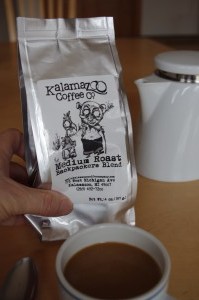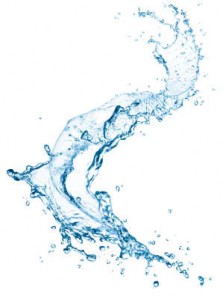

Making My Best Cup: Coffee Fest 2011
I spoke of my best cup of the Coffee Fest 2011 Show as a Sumatra coffee slow brewed for me at the Counter Culture exhibit. My best coffee from Coffee Fest was the Backpacker’s Blend given me in the hall by a small-batch roaster, Kalamazoo Coffee Company from, where else, Kalamazoo, Michigan. He appeared to have just two packages of it, so it seemed all the more precious when he offered one of them to me. I came home and opened the sack to take a whiff – too dark roast, I thought. I didn’t even brew any that day.  The next day lunchtime rolled around. I often brew something slightly darker roasted for my afternoon coffee. I chose to use the Sowden SoftBrew, which steeps the coffee. For reasons thus far unexplained by science, there’s a significant difference between steep method brewers and highly agitated drip or vacuum methods. I’ve heard plenty of conjecture, but no solid facts. Let’s just say they’re different.
The next day lunchtime rolled around. I often brew something slightly darker roasted for my afternoon coffee. I chose to use the Sowden SoftBrew, which steeps the coffee. For reasons thus far unexplained by science, there’s a significant difference between steep method brewers and highly agitated drip or vacuum methods. I’ve heard plenty of conjecture, but no solid facts. Let’s just say they’re different.
To brew using this method, I decided to emulate the formula used by Peet’s Jim Reynolds in his French press tutorial in my Coffee Brewing Secrets DVD. Jim used a rather robust grounds-to-water ratio: 57grams for four six-ounce cups. Of course, I ground coarse, as coarse as my Preciso grinder would allow. I preheated the SoftBrew inside and out so that when the water was poured in to mix with the grounds it would not be suddenly cooled by unheated porcelain or the filter’s cold steel. I heated the water to a full boil, and started a stopwatch. One minute from the boil, I poured enough water over the grounds, just as Jim did. After another minute, I poured the rest of the water into the SoftBrew. I covered it and timed the entire time from the first water was place in contact with the grounds until I poured the coffee, four minutes.
 Often I find steeped methods have paradoxically harsh flavor, which I believe comes from people pouring still-boiling water over the grounds. I say paradoxically because the brew often tastes underdone, indicating the water has cooled too rapidly. All steep methods are going to experience heat-loss during brewing, but the act of pre-warming the pot would seem to circumvent at least some of the initial temperature drop.
Often I find steeped methods have paradoxically harsh flavor, which I believe comes from people pouring still-boiling water over the grounds. I say paradoxically because the brew often tastes underdone, indicating the water has cooled too rapidly. All steep methods are going to experience heat-loss during brewing, but the act of pre-warming the pot would seem to circumvent at least some of the initial temperature drop.
Just before I poured the coffee brewed in the SoftBrew I gave the whole mixture inside a stir. I did this because the grounds can’t help but move towards the top of the brewer during soaking. This means the coffee towards the top is going to be stronger than that at the bottom. I want everyone to enjoy the same brew strength in their cup. The stirring does increase the likelihood of fine grounds in the coffee, but I think it’s a small price to pay as well as a small increase in fines.
The coffee was perfect. The roast was definitely towards the dark side, but minus any perception of bitterness or burnt caramel that dominates so many darker roast coffees. There was still a healthy brightness of acidity in each taste. This was a coffee that would stand up to cream nicely, but I enjoyed it just as it was.
My thanks and compliments to Kalamazoo Coffee Company. It was indeed my best cup after the show.
Let’s Talk Water: Myth Versus Reality
Water is the number one subject people ask about. Water is the solvent that brings for the oil from the grounds. Without water, there’s no coffee. Learning about water and how to view it helped me enormously to brew better coffee. As in most things coffee, there are lots myths surrounding water. I want this to be short and sweet. Here’s my quick opinionated practical guide to brew great coffee.
 Hard Water
Hard Water
“Hard water won’t extract because it’s already too full of minerals.”I hear it all the time. Don’t think of water as absorbing coffee oils. Think salad dressing. Oil and water don’t mix. Think of heated water being a solvent that removes coffee oil from the grounds and they get mixed into the hot water, making the beverage known as coffee. Also, when water is heated the minerals go into suspension. They are virtually unimportant during brewing. What minerals do is add taste. The reason not to use highly mineralized water is they risk adding a flavor that competes with or clashes with your coffee flavor. If that’s not reason enough, hard water suspended during heating, cools and hardens on the insides of your coffeemaker’s plumbing. It doesn’t take much to clog your coffeemaker’s arteries and interfere with the flow. This causes everything from substandard brewing temperatures, to slowing down brewing to simply halting the process. A coffeemaker manufacturer’s repairman once told me the majority of their service was simply calcium-choked coffeemakers.
If you have highly mineralized water, you should do the following: Drink some. If it tastes good, you can brew coffee with it. If the water doesn’t taste good, you shouldn’t brew with it because it will flavor your coffee, almost always it will taste bad. For bad tasting water use bottled water. For very hard water, you can choose. If you are willing to routinely be running vinegar or Urnex (a good coffeemaker cleaner) through your machine, and use fresh water (better still distilled or low-mineral bottled water) to rinse afterwards, you can continue to use hard water. But consider if your water is hard enough, you won’t save much by just switching to bottled water, compared to buying vinegar, coffeemaker cleaner and bottled water to rinse the machines.
Bottled Water
If you use bottled water, check to see that it is low enough in minerals to make a difference. Usually it is lower simply because most bottled water manufacturers do some filtration to make their products consistent… but not always. Some bottled waters are full of minerals and not even any softer (meaning lower in mineral content) than the hardest tap water. The most reliable waters for brewing coffee are so-called drinking water, which are usually highly filtered municipal waters. Most often, they are treated with reverse osmosis filtration, which all but eliminates minerals. Then, the water bottler adds some particles in controlled amounts, just enough to add ‘normal’ flavor – water with no minerals can taste ‘flat’. There are some excellent good-tasting bottled waters, both low in minerals and with good taste that are not r/o filtered, but they take a little patience to find.
Softened Water
Under no circumstances should you use softened water, meaning water that’s been treated with a home water softener. Actually, there is an exception – espresso machines sometimes benefit from softened water, but these are dedicated machines and it’s a special case. I’m still not certain I fully approve of it, but at least it qualifies as a possibility – with espresso. This is not true using drip, vacuum or press pots. Softened water is especially problematic with automatic drip machines, where softened water and ground coffee can combine to make gelatinous goo that will become stuck in your brew basket.
Softened water is virtually undrinkable anyway due to its elevated sodium content. I anticipate the question of alternate softening methods. To be honest, I don’t know, nor do I know if it’s been researched by anyone. I’m eager to learn if any tests have been done.
So, there are the coffee basics you need to brew great coffee minus the myths.
No Results Found
The page you requested could not be found. Try refining your search, or use the navigation above to locate the post.

